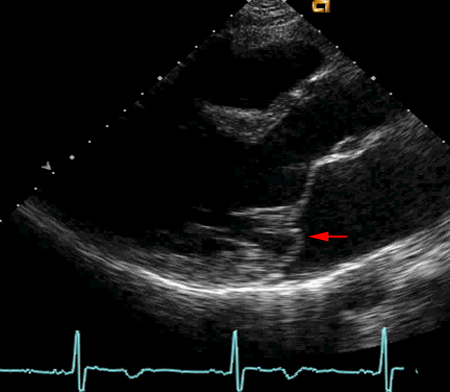Tests
1st tests to order
echocardiogram
Test
Key test indicated to confirm diagnosis and assess high-risk features.
Sensitivity and specificity are high when current diagnostic criteria are used.
Also useful for routine follow-up studies or for change in clinical status.
Predictors of poor outcome include moderate to severe mitral regurgitation, left ventricular ejection fraction <50%, left ventricular dilation, and leaflet thickening >5 mm.[5][6][34][35][36] The effect of chronic mitral regurgitation on left ventricular systolic function can be latent, and ejection fraction can remain in the normal range when contractility is already impaired.[23][Figure caption and citation for the preceding image starts]: Parasternal long-axis echocardiogram of mitral valve illustrating prolapse of posterior leaflet (red arrow)From the personal collection of Brian Griffin, MD; used with permission [Citation ends].
Result
leaflet prolapse of ≥2 mm above the level of the annulus during systole in the long-axis parasternal view.
Tests to consider
Holter or event monitor
Test
Patients with palpitations or syncope are evaluated with Holter or event ambulatory monitoring to rule out significant arrhythmias. Some patients with MVP experience palpitations in the absence of findings on event monitoring.
Result
may reveal dysrhythmia in patients with palpitations or syncope
cardiac MRI
Test
For patients with unsatisfactory echocardiogram or marked echocardiographic discrepancy with clinical findings.[3][29]
Result
information about underlying mechanisms, accurate quantification of regurgitation, chamber volumes, and myocardial viability; delayed enhancement in papillary muscle and basal inferior wall may indicate arrhythmia risk
Use of this content is subject to our disclaimer